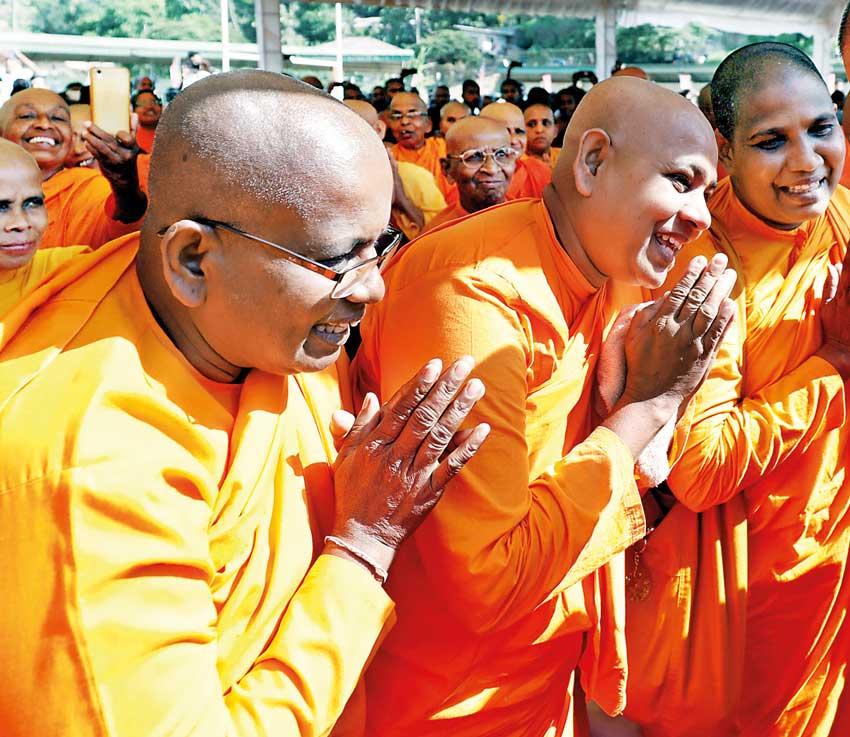Reply To:
Name - Reply Comment

Records of bhikkunis of Sri Lanka are illustrious, especially their initiative in the establishment of the Bhikkuni Order overseas (Picture Reuters)
This spirit of Lankan bhikkunis who emulated the founder, was in sharp contrast with the founding bhikkunis of ancient India
According to Mahavamsa, about six centuries following the founding of the Order in Sri Lanka, eleven Theravada bhikkunis under Devasara Thisarana Theri, accompanied by Theravada bhikkus as required by the rules of the Vinaya, sailed to China in 426CE on board a ship captained by Nandi
 Sanghamitta Theri crossed the seas unheard of for a woman at the time and arrived in Sri Lanka on a Unduwap Poya Day in the third century BCE to establish the Bhikkuni Order. With it she set the pace to elevate the status of Lankan women leading them to literacy, emancipation and the directions of teaching methods of the Doctrine even inspiring bhikkunis to undertake dangerous overseas journeys to establish the Bhikkuni Sasana in foreign lands.
Sanghamitta Theri crossed the seas unheard of for a woman at the time and arrived in Sri Lanka on a Unduwap Poya Day in the third century BCE to establish the Bhikkuni Order. With it she set the pace to elevate the status of Lankan women leading them to literacy, emancipation and the directions of teaching methods of the Doctrine even inspiring bhikkunis to undertake dangerous overseas journeys to establish the Bhikkuni Sasana in foreign lands.
This spirit of Lankan bhikkunis who emulated the founder, was in sharp contrast with the founding bhikkunis of ancient India. Although the Bhikkuni Order was founded at the time of the Buddha and under His close observation it went into extinction with the decline of the late Gupta period.
But in Sri Lanka, which was the only country where the Bhikkuni Order was established outside the Indian subcontinent and the lineage of the Order, persisted unbroken for over 12-13 centuries.
Records of bhikkunis of Sri Lanka are illustrious, especially their initiative in the establishment of the Bhikkuni Order overseas which ultimately attributed towards the survival of the Bhikkuni Order worldwide. According to Mahavamsa, about six centuries following the founding of the Order in Sri Lanka, eleven Theravada bhikkunis under Devasara Thisarana Theri, accompanied by Theravada bhikkus as required by the rules of the Vinaya, sailed to China in 426CE on board a ship captained by Nandi. They, on the invitation of the then ruling Sung Dynasty, ordained 300 bhikkunis in the Capital city of Nankin.
Three years later, Chandramali Theri, along with Theravada bhikkunis and bhikkus, made an arduous journey to Tibet for the ordination of another batch of bhikkunis. The Order thus established by Lankan bhikkunis had spread from there to countries in East Asia. Some of them eventually had been converted to Mahayana Buddhism. The Order however, had continued in some of these countries while it went into extinction in Sri Lanka. Literature gives evidence of the existence of bhikkunis in Kashmir and Tibetan border lands even through the 11th century CE and according to Dalai Lama, quite a few bhikkunis in the West had been ordained by Tibetan bhikkunis.
Around 1500 years later, Sri Lanka stood to gain by this ordination of bhikkunis in foreign lands. In Sri Lanka, with the Chola invasion in the 11th century ACE and in the waning years of the Anuradhapura Era, the Bhikkuni Order went into complete extinction. Great efforts made by Dr. Hema Goonatilleke made it possible to trace that the lineage established by the ancient Lankan bhikkunis of the 5th century ACE, still persists in China, Taiwan, Vietnam and Korea. These bhikkunis, paying a tribute to our 5th century bhikkunis, who crossed the eastern seas and founded their Order, gladly gave ordination and reestablished the Bhikkuni Order in Sri Lanka in 1998. The Bhikkuni Order thus was restored after a lapse of over thousand years.
Women in the 3rd century BCE were living in an agrarian society being primarily engaged with work in the fields. Historical evidence reveal that the founding of the Bhikkuni Order in the 3rd century BCE, changed their life styles earning recognition as fellow citizens.
The introduction of Buddhsim just eight months earlier and the establishing of the Bhikkuni Order by Sanghamitta Theri in the month of Unduwap did bring about stirring religious, cultural, economic, political and social changes to the island. Extraordinary architectural accomplishments, spectacular sculptures and other forms of crafts were changing the landscape of Anuradhapura. Against such an exciting landscape, discourses on Buddhism and debates on the Buddhist Doctrine were drawing bhikkus, bhikkunis and lay people to Arahant Mahinda’s Aramaya in the Mahamevna Uyana (which later became the Mahavihara ) and the Sanghamitta Theri’s Upasika Viharaya.
Discourses however, were conducted in Pali. Only Arahant Mahinda who had learnt Sinhala, preached in the Sinhala language. The language used by the clergy including Sangamitta Theri was Pali which compelled bhikkunis to learn Pali then considered as an elite language. And with oral-tradition yet being the norm, bhikkunis learnt Pali to listen, understand and participate in discourses. But they preached and interacted with the lay people in Sinhala.
With scholarly work going apace, monasteries of bhikkus and bhikkunis, developed into renowned centres of learning which led Anuradhapura to be cited as the centre of Buddhism in Asia. Religious and educational institutions attracted scholars.Dignitaries and emissaries from the Indian subcontinent and China arrived for dhamma studies.
While the Bhikkuni Order grew in strength and of erudition, the learning of Pali had continued into the mid millennium. With the commencement of documentation, they wrote the first Pali chronicle on the island’s history – the Dipavamsa, signifying the impact the Bhikkuni Sasana had made on literacy levels of women of ancient Sri Lanka.The 22-chaptered volume in Pali had been written by several generations of Bhikkunis over a period of about hundred years – from the 4th to the 5th centuries and served as source material for post Dipavamsa documentations including the Mahavamsa.
With detailed accounts containing of the Bhikkuni Order from the inception of Maha Prajapathi Gothami through Sanghamitta Theri up to the time of King Mahasen, scholars had identified the Dipavamsa as the earliest historical chronicle perhaps of the whole of Asia.The fact that it belonged to Sri Lanka’s earliest literary period gives evidence of the advancement that had existed in early Bhikkuni Monasteries. According to scholars, Dipavamsa had been heavily influenced by monastery-literary-tradition.